Brahman Bhojan, Agnoukaran & Pindapujan Ritual
Contents
1. Preparation for serving the meal at the time of shraddha
2. Ritual of Agnoukaran in the Mahalaya shraddha
3. Serving meal to the brahmins in the Mahalaya shraddha
5. If a person (Jiva) is already reborn, what is the use of taking his name?
6. The Pindapujan of Mahalaya Shraddha
7. Options available if one is unable to perform the ritual
1. Preparation for serving the meal at the time of shraddha
The brahmin invited for the place of the deceased ancestors (pitars) in the ritual is seated facing the north. He is called the pitar-brahman. The brahmin invited for the place of Deity in the ritual is seated facing the east. He is called dev-brahman. A small square is marked with water on the ground in front of the Dev-brahman from the northwest to the northeast and the banana leaf is placed on it to offer the meal to him. A circle is marked on the ground with water in front of the pitar-brahman in the same way. Thereafter the meal is served on leaves to the Family Deity, Deities worshipped traditionally in the house, cow, for pindbhojan etc. A sheath of Holy ash (bhasma) is drawn around the leaf to prevent negative energies from creating obstacles in the meal.
The three main aspects of the ritual of shraddha are :
A) Offering oblation in the fire (Agnoukaran). In the Rugved period, pitrupuja was performed by offering the pinda as oblation in the sacrificial fire.
B) Offering meal to the brahmins (Brahman-bhojan)
C) Pindpujan, that is, offering the pinda.
2. Ritual of Agnoukaran in the Mahalaya shraddha
In agnoukaran ritual, ghee is first smeared on the leaves to purify them. The person performing shraddha sits in front of the pitar-brahman, places cooked rice on a small leaf, and puts ghee on it. This heap of rice is parted in two with the help of a darbha. Fire in the form of darbha is installed on the hand. After making two parts of the rice, the person performing shraddha picks up some rice from the center of the rice on the north side in his right hand. He smears it with ghee by his left hand and places it in the hand of the pitar-brahman. This action means, oblation to pitars in the form of Soma, that is, Deity and to fire.
A rule laid down by the Vedas is, The entire world is in the form of fire (Agni) and Soma. In the agnoukaran ritual, by offering oblation of rice in the form of Soma Principle in the fire which is in the form of darbha, the pitars get the essence of food.
3. Serving meal to the brahmins in the Mahalaya shraddha
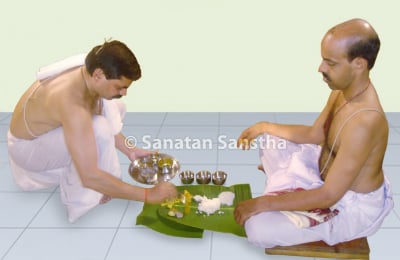
Serving meal to the Brahmin
For this meal, food items are served on a banana leaf in a specific manner. The person performing the shraddha sits in front of the Dev-brahman by placing his folded right knee on the ground and offers the leaf to Vishvedev. Then by holding the right hand of the Dev-brahman, meal is offered to Vishvedev. A prayer is made, ‘Let this food be partaken’ and also, ‘Let the fruit of offering food close to Vishnupad at Gaya ji be acquired.
In the ritual of shraddha, reference to Gaya ji appears many times. The place, Gaya ji is charged with subtle, inferior desire vibrations. Hence, shraddha performed there is more fruitful.
A) The banana leaf is offered to the pitars by placing the bent left knee on the ground in front of the pitar-brahman.
B) The food is offered by holding the hand of the pitar-brahman in a reverse manner.
C) Now the person performing the shraddha says, ‘I have offered you the meal considering you in place of my pitars of this particular lineage (gotra). Please partake it. Let me acquire the fruit similar to food offered at Gaya.
D) Now both the brahmans offer pranahuti.
E) Shlokas should be recited during the meal of brahmans (brahman bhojan).
F) After the meal is over, the person performing the shraddha stands up and asks, ‘Are you satiated?’
G) Brahmans express their agreement. The person performing the shraddha asks, ‘What should be done with the remaining food?’ Brahmins say, ‘Let the family members have it as Holy sacrament (prasad).’
The Moon channel gets activated by sitting with the right knee on the ground. Hence, the person performing the shraddha can easily receive the frequencies of Deities. The Sun channel gets activated by sitting with the left knee on the ground. Sun channel is associated with raja guna. It becomes easier to invoke the pitars with the help of this raja guna. In a way, brahman bhojan is an oblation given in the fire present in the stomachs of the pitars and Deities.
4. How are the pitars in various forms of existence
satisfied by the food offered in the ritual of the shraddha ?
For the nourishment of the physical body, gross food is necessary. Deceased ancestors do not have the sheath of the physical body (annamaya-kosh) but have the mental sheath (manomaya-kosh) containing desires. Stomach getting full and becoming satiated are two different things. As per the Science of Spirituality, getting satisfied is associated with the subtle body. The necessary subtle essence of food is carried to the deceased ancestors, in the form of Divine nectar if they are in Deity form of existence, as edibles if they are in the celestial being form of existence.
5. If a person (Jiva) is already reborn, what is the use of taking his name?
To give the portion offered to the deceased ancestors in the shraddha to the particular subtle body is the responsibility of the Deities of Pitruloka. The mental sheath, that is, the baggage of previous birth accompanies a person. The action addressed to this baggage definitely reaches there. If without any reason we suddenly feel satiated on some day, we can surmise that somewhere our son from the previous birth has performed our shraddha.
6. The Pindapujan of Mahalaya Shraddha
The Pindapujan has been mentioned in the Yajurveda, Brahman, Shrutis and the Gruhya Scriptures. According to Mahabharat, Varahadeva, the incarnation of Sri Vishnu, gave complete information about shraddha to the world. He took out three pindas from His molar tooth and kept in the south direction on a darbha. Proclaiming that ‘these three pindas should be considered as the forms of the father, grandfather and great grandfather’, He performed ritualistic worship of the pindas with sesame seeds.
The remaining portion of the rice meant for Agnoukaran is added along with Tilodak, black sesame seeds, curd, honey and ghee to the rice. Four big pindas and other small pindas are made as per requirement. The big pindas should be of the size of a Bel fruit. The venue is purified with the Tilodak and darbha is spread on it. Darbha is purified. While placing every pinda, the person performing the shraddha says, ‘I am offering the pinda in the name of so-and-so relative of so-and-so name in the form of Vasu or Rudra or Aditya of so-and-so lineage, that is, gotra. It is my faith that I am offering the pinda in Gaya.’
After offering a pinda for those about whom one has definite information, a Dharmapinda is offered. This Dharmapinda is given to the deceased ancestors who are in the Hell region of Asipatravan and Kumbhipak, those whose family lineage has ended and others. Kajal is made by mixing ghee with burnt darbha. The deceased ancestors in the form the pinda are offered kajal, a thread of wool, a flower, a Tulasi leaf, maize, incense, lamp etc. They are then offered Holy sacrament (naivedya), water for drinking, washing hands and cleaning the mouth and a betel leaf for mouth freshness. Now the person performing the shraddha stands, offers barley and black sesame seeds and says, “O my deceased ancestors! I Pray for food and strength for my family and that all should progress. O deceased ancestors! Grace us with wellbeing.’ Thereafter the Pitru-brahman is given Tilodak and the Dev-brahmin Yavodak and water is released on the pinda.
Tilodak is offered on a special pinda made for those deceased ancestors who had died by burning in fire or who died in the womb. The person performing the shraddha asks, ‘Are the Vishvedev appeased ?’ ‘Are the deceased ancestors appeased ?’ After saying, ‘Let all the Deities be appeased and the karma of shraddha be done as per the Scriptures’, the person performing the shraddha pays obeisance. The priests say, ‘’Let the desire of the person performing the shraddha be fulfilled by the grace of Deities and the deceased ancestors’’. Thereafter, the other members of the family pay obeisance to the pindas.
After this, the person performing the Shraddha remembers the seven places that bestow Final Liberation; Ayodhya, Mathura, Gaya, Kashi, Avantika, Dwaraka and Jagannathapuri and places the pindas in a big vessel.
The person performing the shraddha pays obeisance after the conclusion of the ritual. The pindas are immersed in clean flowing water before sunset. Food is served on a leaf outside the house for the crow. In the ritual of tarpan, first tarpan is done for the Vishvedev and thereafter for the deceased ancestors. The person performing the shraddha says, ‘I am offering water, I am offering water, I am offering water in the name of so-and-so relative of so-and-so name in the form of Vasu or Rudra or Aditya of so-and-so lineage, that is, gotra.’ Thereafter for the sake of those born in the family lineage (gotra) who had no sons, a corner of a cloth is dipped in the Tilodak, the cloth is squeezed and water is released.
Subtle experience of the subtle at the time of the pindapujan in a ritual of shraddha: Some pindas are placed at the center of the darbha. Four Dharmapindas are placed in the four corners. Red rays are emitting from the dharmapindas, a symbol of dharmashakti. Yellow spirals of Chaitanya are seen around the pindas of pitars.
7. Options available if one is unable to perform the ritual
If a person is unable to perform this ritual, many options are open to him. If brahmin is not available for brahman bhojan, darbha is used. If performing the ritual is not possible, then merely reciting the ritual with faith is also useful. The person can choose any option. The main objective in clarifying all this is that shraddha must be performed in pitru-paksha. The importance of faith in the ritual of shraddha has been explained in Brahmapurana as :
तस्माच्छ्राद्धंनरोभवत्या
शाकैरपियथाविधि।
कुर्वीतश्रद्ध्यातस्य
कुलेकश्चिन्नसीदति।।
Meaning : If a person performs shraddha using mere grass but with faith and devotion, then nobody in his family becomes unhappy.


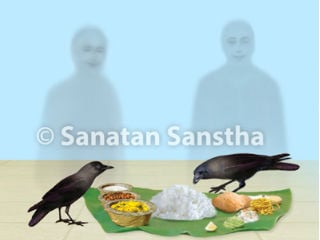 How to perform Mahalaya shraddha in Pitrupaksha during the Coronavirus pandemic ?
How to perform Mahalaya shraddha in Pitrupaksha during the Coronavirus pandemic ?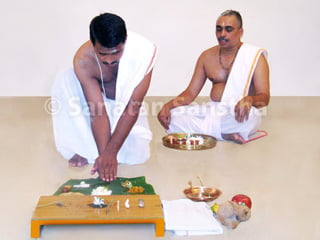 When should the Shraddha be performed ?
When should the Shraddha be performed ?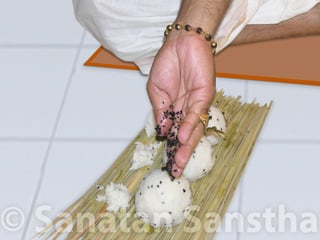 When can women perform Shraddha ?
When can women perform Shraddha ?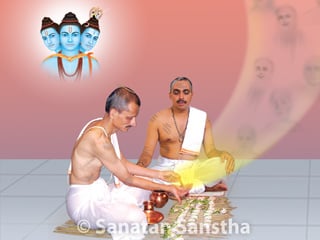 Why should every son perform ritual of Shraddha?
Why should every son perform ritual of Shraddha?